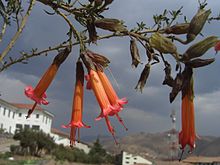| Cantua buxifolia | |
|---|---|

| |
| Cantutas in the garden of Qurikancha (today's Convento Santo Domingo) | |
| Scientific classification | |
| Kingdom: | Plantae |
| Clade: | Tracheophytes |
| Clade: | Angiosperms |
| Clade: | Eudicots |
| Clade: | Asterids |
| Order: | Ericales |
| Family: | Polemoniaceae |
| Genus: | Cantua |
| Species: | C. buxifolia
|
| Binomial name | |
| Cantua buxifolia | |

Cantua buxifolia, (/ˈkæntjuə bʌksɪˈfoʊliə/, Hispanicized spellings cantuta, cantu), known as qantu, qantus or qantuta (Quechua,[1]) is a flowering plant found in the high valleys of the Yungas of the Andes mountains in western South America. Also known as the Peruvian magic tree,[2] it is an evergreen shrub growing to 4 m (13 ft) tall by 2.5 m (8.2 ft) wide with small leaves and clusters of brilliant pink, narrow tubular flowers in early spring.
It is the national flower of Peru and one of two national flowers of Bolivia, the other being the patujú (Heliconia rostrata).The Bolivian national flower is in fact a particular variety of qantuta, the qantuta tricolor, which has red petals, a yellow floral tube and a green calyx,[citation needed] reflecting the colors of the national flag.
The Latin specific epithet buxifolia means "with leaves like Buxus (box)".[3]
This plant requires sheltered conditions where the temperature does not fall below −5 °C (23 °F). In climates colder than that, it should be grown under glass but may be placed outside in summer. This plant has gained the Royal Horticultural Society's Award of Garden Merit.[2]
- ^ Teofilo Laime Ajacopa, Diccionario Bilingüe Iskay simipi yuyayk'ancha, La Paz, 2007 (Quechua-Spanish dictionary)
- ^ a b "RHS Plantfinder - Cantua buxifolia". Retrieved 24 January 2018.
- ^ Harrison, Lorraine (2012). RHS Latin for Gardeners. United Kingdom: Mitchell Beazley. ISBN 978-1845337315.